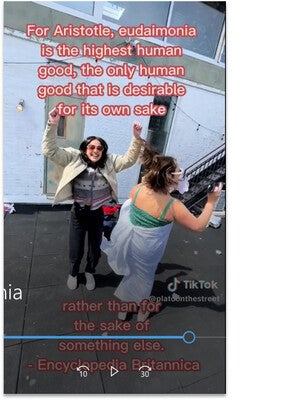Plato, TikTok… skydiving? Yale’s Gendler gives ancient texts a modern spin

In “Public Plato: Ancient Wisdom in the Digital Age,” Tamar Gendler, dean of Yale's Faculty of Arts and Sciences and Vincent J. Scully Professor of Philosophy, merged core texts from Western philosophical traditions with findings in cognitive science to explore how ancient philosophy can engage modern audiences. (Photo by Dan Renzetti)
In January, Tamar Gendler began a six-month leave from her duties as dean of Yale’s Faculty of Arts and Sciences (FAS). But she was hardly sitting still.
During the spring semester, Gendler, who is also the Vincent J. Scully Professor of Philosophy and professor of psychology and cognitive science, returned to the classroom for the first time since the start of the COVID-19 pandemic to teach one of the most complex and layered courses she’s ever offered.
The new course, “Public Plato: Ancient Wisdom in the Digital Age” (PHIL 334), built on an earlier online course in which Gendler merged core texts from Western philosophical traditions with recent findings in cognitive science to explore how ancient philosophy can engage modern audiences. The earlier version of the course reached students worldwide through the Open Yale Courses website. This time around, she offered the course as a classroom seminar to a cohort of eight Yale College students, with plans to develop an online version for Coursera. Each session was recorded and, with the help of Yale’s Poorvu Center for Teaching and Learning, Gendler will meld excerpts of seminar discussions with the recorded lectures to create a brand-new online course. She hopes the online course will be available this fall.
In a recent Yale News interview, Gendler, who returns to her role as dean on July 1, discussed why she was eager to return to the classroom, why her students were inspired to delve into activities seldom associated with philosophical curricula (think TikTok videos and skydiving), and why she thinks the merger of philosophy and technology continues a scholastic tradition that goes back millennia. The interview is condensed and edited.
Why did you decide to return to the classroom? And why did you want to tackle this course specifically?
Tamar Gendler: Well, I was taking a six-month leave from my role as dean, and I decided that I wanted to use the time to think about a set of questions that I've been considering for the past decade. Specifically, I wanted to explore how we might take a set of traditional philosophical works from the Western tradition — particularly some ancient texts that I’ve been so moved by — and translate them into something that feels contemporary. I wanted to find a way to teach them in a way that makes apparent their power to speak to individuals, so that we can all benefit from their ideas even if they didn’t happen to emerge at the moment we are living. Really, it’s part of a general project that asks how you open up the really interesting ideas of the world to people.
About a decade ago, I taught a more conventional version of this course in my Open Yale Course [“Philosophy and the Science of Human Nature”], which I used to call “Dead Guy Tuesday/Cog-Sci Thursday,” because I basically paired ancient texts (which we discussed on Tuesdays) with contemporary cognitive science (which we discussed on Thursdays). That course achieved about half of what I wanted to do in this new course. The other half that I wanted to achieve with this course was to think about the way in which the modality of expression itself determines the capacity of the audience to receive information. And we did that analytically and in practice.
For example, we would take a scientific idea — say, an idea from Daniel Kahneman [a Nobel Prize-winning Israeli-American psychologist who integrated cognitive psychology and economics] — and trace it from his original scientific paper through his own popularization of it. And then we’d look at Malcolm Gladwell’s popularization of Daniel Kahneman, and then an article in Seventeen Magazine on Kahneman’s work, and then a little clip about it on social media. We’d look at all of these and talk about what gets lost and what is gained in these various kinds of translational exercises. And we talked a lot about how the framing of a concept makes it feel accessible or inaccessible.
What’s an example of how the framing of an ancient text might make it more accessible to modern readers — and how that framing might affect its meaning?
Gendler: For the new course, we read Epictetus’s Handbook, which famously starts, “Some things are up to us, and some are not up to us…” which is, of course, the origin of what has come to be known as the Serenity Prayer — “God grant me the serenity to accept the things I cannot change, the courage to change the things I can, and the wisdom to know the difference” — and the foundational intellectual basis for the 12-step movement. We spent about half a class discussing a pair of images, both of which featured the Serenity Prayer: one was a delicate ceramic plate where the text was surrounded by morning glories and puppy dogs, and the other was the same text in the form of a bicep tattoo surrounded by American flags and tanks. Epictetus’s point is that how you frame content determines how you perceive it. And here we had, with the text of Epictetus, two cases of literal frames, one of which made the text seem gentle and available to those who might feel soothed by it, and the other of which made it seem macho and available to those who self-conceive in that way. So that conversation offered three different weavings of meta in the same place.
How did the format of the course differ from the version you taught before?
Gendler: I realized I could have a tiny seminar that could also be a seminar for a million people by offering a version of it through Coursera. This meant that I taught only half of the material that I’d taught in the earlier class, since the new course was just 13 topical two-hour seminars [instead of a course with 26 distinct lectures plus weekly discussion sections]. But the new format allowed us to go into every concept in greater depth. And I realized I could have taught a quarter of this material and it still would have been engaging.
Also, the earlier course was a lecture with about 300 students. This time I had just eight students, so we could work really intimately together. We also recorded all of the classes for use in a later version of the course that will be offered on Coursera. And the students were all in. They viewed their role as teaching this material to the Coursera audience, so there are lots of times where they would say something and then they’d say it again looking at the camera. There was a fourth wall, because we were such an intimate group, but we also kept breaking that fourth wall.
Asking students to play such an active role on camera obviously isn’t a typical expectation. Did you have to pre-screen the students to make sure they would be a good fit?
Gendler: There was a prerequisite that students had to have seriously read and engaged with Plato’s “Republic” prior to taking the class. At one level the entire course simply required reading three books: Plato’s “Republic,” Aristotle’s “Nicomachean Ethics,” and Epictetus’s “Handbook.” So I needed students for whom reading ancient texts would feel comfortable. I ended up with a large percentage of the students having backgrounds from Directed Studies [a program that offers a select group of first-year students an intense interdisciplinary introduction to some of the seminal texts of Western and Near Eastern cultures], but the course was also cross-listed with cognitive science, psychology, and education studies. So almost all of the students also had interests in empirical psychology or cognitive science.
They were ready to bring their A-game to these discussions.

Gendler: Oh, they brought an A-game. And they brought a huge range of backgrounds. I had sophomores who were basically just getting their intellectual footing. I had seniors for whom this was literally their last semester. I had a student in his 50s from the Eli Whitney program who came from a military background and who offered such terrific contributions because one of the subthemes of the course is military experience. For instance, we read “The Iliad” and a book called “Achilles in Vietnam,” which is about post-traumatic stress disorder in Vietnam vets as read through the description of the scene in the Iliad where Achilles goes mad in the face of the death of Patroclus.
The class also did a group of crazy, creative group projects. One team produced a series of TikTok videos about Plato called “Plato on the Streets,” where a student dressed up as Plato, wandering around campus in a toga, and interviewed strangers. Two students did a series of interviews with Yale faculty and students about the notion of procrastination and the way in which ancient philosophy and cognitive science examine it. Two others decided to study this notion, known as alief [a term coined by Gendler herself], which is basically when you have an automatic but irrational attitude towards something. They decided that one activity people think is dangerous but actually isn’t dangerous is skydiving. And they ended up taking the entire class skydiving.
Beyond illustrating the influence and role of technology, it seems that you used technology to engage the students, to draw them into the conversation.
Gendler: There are a lot of domains where the students’ expertise deeply exceeds mine. One of the students was a TikTok star in Brazil, for example. And in some sense, the course is supposed to be about how to take something, make it meaningful, and share the ways in which it’s meaningful for you.
The course was always grounded in these three books [Plato’s “Republic,” Aristotle’s “Ethics,” and Epictetus’ “Handbook”], but it was crucial for me that the class also be experimental. So we didn’t read all of the books in order, but by the end of the semester we had read them all multiple times, with a level of a substantive engagement that allowed the students to explore these difficult texts and contemplate how they made a difference in their daily lives.
This doesn’t sound like my undergraduate philosophy classes — and I imagine isn’t how many students learn philosophy. Is that part of the point?
Gendler: It’s interesting. Most philosophy, when it was done, made use of new technologies of the time. Socrates made use of the technology of the Agora [public spaces for assembly in ancient Greece]. Epictetus used the technology of meditation. Hobbes tried to make sense of the science of his time. Confucius asked: how do I structure a society? All of our early modern philosophy is an attempt to deal with the empirical nature of Galilean and Newtonian science. So I think philosophers actually do tend to be involved in the cutting-edge technological questions of their time. But while the work of philosophers is enduring, the fact that they are at the cutting edge of technology is invisible to us.